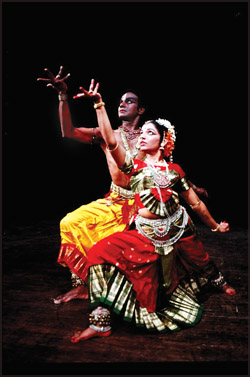|
The role of females and males in the field of
classical:
Bharatha Natyam
SUBASHINI PATHMANATHAN
All the Indian classical dances play an important role in the
cultural life of the Indian masses. Culture reveals the pattern of
lifestyle, customs, and traditions relating to regional, religious,
linguistic, and historical background of the society.
 From the very beginning, the female temple dancers, and court female
dancers enjoyed prestigious position in the society. Earlier temple
dancers were called Devar Adiyarkal, or Devadasis. Similarly, royal
palace dancers were called Rajadasis. Those dancers who served in the
Shivan temples were called Rishabath- Thali-Yeayalar. From the very beginning, the female temple dancers, and court female
dancers enjoyed prestigious position in the society. Earlier temple
dancers were called Devar Adiyarkal, or Devadasis. Similarly, royal
palace dancers were called Rajadasis. Those dancers who served in the
Shivan temples were called Rishabath- Thali-Yeayalar.
Vaishnava temple dancers were called as Sri Vaishnava Manikam, and
Vaishnava temple male dancers were called Arraiyer. Before the birth of
Bharatha Natyam, temple dancers were called Sathir-Kaaris. Even the
temple dancers were called Pathiyea-Yalar. Pathi means temple.
Even earlier on temple wall paintings, dance stage decoration
paintings, dance mandapa paintings, stage curtain paintings, and temple
gopura sculptures were decorated with female dancers. Female dancers are
depicted in most of the temple pillars.
Besides these, there is evidence of numerous stone and copper plate
inscriptions in different periods, which refer to the female dancers,
their names and their different details. Numerous awards, and titles
were awarded to the male and female dancers.
After the birth of Bharatha Natyam, the main performers, professional
dancers, the outstanding dance teachers, and research scholars in
Bharatha Natyam are females. But the traditional gurus were males; today
some non traditional male dance teachers, and dance performers are in
this field, while compared to female dancers the total number of male
dance teachers and performers in Bharatha Natyam are very few.
Bharatha Natyam is mostly regarded as a female art, yet Thandava
Stances and Nirutha Adavus, which have firm, stiff and steady movements
are performed by the female dancers. The Lassiya division and nirthya
movements including subtle facial expressions, emotional Bhavas and
Rasas, are expressed by the females, more gently, gracefully and
emotionally than the males.
The personality of the females are more attractive on the stage. Even
the late E. Krishna Iyer adorned himself as a female and danced to show
the public the spirituality and divinity of Bharatha Natyam.
The female Bharatha Natyam artistes use different designed costumes,
such as pyjamas with straight pleated costumes, with permanently pleated
shawl, along with normal saree blouse. Slanted pleated pyjama costumes
from left to right, sometimes pleats overlap each other in three layers.
The female artistes also wear short sarees. Some female artistes
instead of wearing short sarees, have readymade tailored short sarees.
Even sometimes they wear skirt costumes with front pleats.
The male Bharatha Natyam artistes wear dhoti with tharu or pyjama
costumes with less pleats in front. The male dancer's upper body is
bare, and covered with ornaments, or glittering shawl.
Today in Bharatha Natyam repertoire, numerous items are included,
such as Meenakshi Thaalaatu, Meenakshi Kaliyanam, Sitha Kaliyanam,
Andal, and Kurathi are included. For such items, especially designed
costumes are selected. these dances are performed only by the female
artistes.
Female dancers use beautiful facial and head ornaments, but such
elaborate hair dressings are not used by the male dancers.
The female artistes wear Uchipattam, with a pendant dangling on the
forehead. Nethipadam is a pearl and stone studded chain which is firmly
secured to the Uchipattam.
Sometimes the Uchipattam is used alone without the nethipadam. On the
right side of the Uchipadam, another ornament is worn-that is known as
Suriapirai, and on the left side of the Uchipattam, Chandrapirai is
worn.
At the end of the Uchipattam the Rakodi is worn. The Rakodi depicts
the head of the peacock, against the background of the peacock feathers.
Only the female artistes wear this heavy hair ornaments, whilst the male
dancers do not wear the hair dressings.
Besides the female Bharatha Natyam artistes use beautiful natural and
artificial flower garlands for hair dressing, but these are not used by
the male dancers. Another hair dressing used by the female artistes, is
known as Chadanaagam, which is woven along the plaited hair, at the end
of the Chadanaagam, three Kunchams are attached.
Nose studs, pillaku, nathu are some of the nose ornaments worn by the
female dancers only. Similarly ear ornaments such as, simiki, and
kannasaram are also worn by the female artistes.
But certain ornaments such as Maangaimalai (mango chain), Kasumalai
(coin chain), Pearl Malai with three strands attached with pendants,
depicting peacock, or parrot, or swan, or goddess Mahalakshmi are some
of the neck ornaments which are worn by female as well as male dancers.
A pair of wangi, are worn on the upper arms, are used by both the
females and the males. Oddiyanam waist belt, and the waist chain, worn
below the Oddiyanam, and ear studs are common ornaments for male and
female artistes.
As for the accompaniments the Nattuvangam, vocalists, flutists, and
violinists are males or females. But the Miruthangamists are mostly
males. Similarly the hair dresser is a female and the facial make-up is
done by the men. The stage decoraters, stage sound and lighting system
technicians are generally men. |

